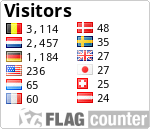Albertkanaal - Albertcanal EarthCache
This cache has been locked, but it is available for viewing.
Albertkanaal - Albertcanal
-
Difficulty:
-

-
Terrain:
-

Size:  (not chosen)
(not chosen)
Related Web Page
Please note Use of geocaching.com services is subject to the terms and conditions
in our disclaimer.

In de jaren
tachtig van de vorige eeuw zijn bij de verbreding van het Albert
kanaal de afgegraven taluds geologisch onderzocht. Hierdoor weten
we hoe de verschillende grondlagen elkaar opvolgen in deze streek.
Aan de basis ligt een dik pakket kalksteen – ook wel
‘mergel’ genoemd – uit het Laat-Krijt en
Vroeg-Tertiair (70–60 miljoen jaar oud). In deze gesteenten
worden fossielen van zeedieren gevonden, zoals schelpen en
zee-egels maar ook een beroemde fossiel. In de kalksteen bevinden
zich op regelmatige intervals ook lagen van vuursteen of
‘silex’. Daarop ligt een laag zand uit het
Midden-Tertiair (35-30 miljoen jaar oud). Hier en daar zijn in deze
kalkloze zanden snoeren van kleine gerolde vuurstenen – de
zogenaamde ‘aardappeltjes’ – aanwezig. Zij geven
aan dat hier destijds een strand aanwezig was.
Op het zand
volgt een grindpakket van vier tot zes meter dik, dat ongeveer
550.000 jaar geleden tijdens een ijstijd werd afgezet door de
toenmalige Maas. In dit grind komt vuursteen van goede kwaliteit
voor, dat de Maas stroomopwaarts uitschuurde uit het dieper
liggende kalksteenpakket. De bovenste laag is Löss wat gebruikt
wordt voor het vervaardigen van baksteen.
Om
deze cache te loggen maak je een foto van iemand van je team op de
stenen stoel bij het kanaal en beantwoord je deze
vragen:
1.
Wat is de naam van het beroemde fossiel dat hier gevonden
werd?
2.
Wat is de kleur van de bovenste laag?
MAIL
JE ANTWOORDEN NAAR MIJ VOOR GOEDKEURING. LOGS MET EEN VERKEERDE
FOTO OF LOGS VAN MENSEN DIE EEN FOUT ANTWOORD OP DE VRAgEN GEMAILD
HEBBEN WORDEN DIRECT VERWIJDERD!!!
In the
twentieth century eighties, while broadening the Albert canal,
excavated slopes have been geologically examined. Consequently we
know in which manner the different layers are structured in this
area. At the basis is a thick package of limestone – also
called ‘marl’ – from the Late-Chalk and Early-
Tertiary era (70–60 million years old). Fossils of marine
animals have been found in these rocks, such as shells and see
urchins but also a very famous fossil. The limestone also holds
layers of flint or ‘silex’ at regular intervals. Above
is a layer of sand from the Middle-Tertiary era(35-30 million years
old). In this chalkless sand cords of small rolled flint stones are
present here and there, the so-called ‘potatoes’. They
indicate that there used to be a beach at the time. Next on top of
the sand is a package of gravel which measures 13 to 20 ft, created
some 550.000 years ago during an ice age by what used to be the
river Maas. The gravel holds some good quality flint, sanded out
upstream by the Maas from the underlying limestone package. The
upper layer is Löss, used as raw material for making
bricks.
To
log this cache you must take a picture of someone of your team on
the stone chair near the canal and answer this
questions:
1.
What is the name of the famous fossil the was found
here?
2.
What is the colour of the upper layer?
MAIL YOUR
ANSWERS TO ME FOR APPROVAL. LOGS WITH A WRONG PICTURE OR LOGS FROM
PEOPLE THAT E-MAILED INCORRECT ANSWERS TO THE QUESTIONS ARE REMOVED
IMMEDIATELY!!!
Additional Hints
(No hints available.)